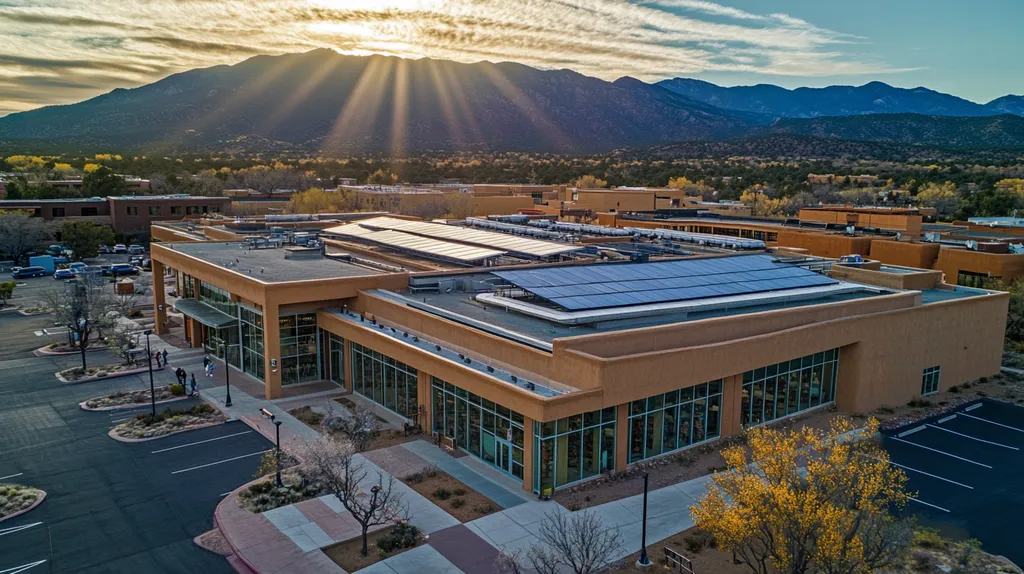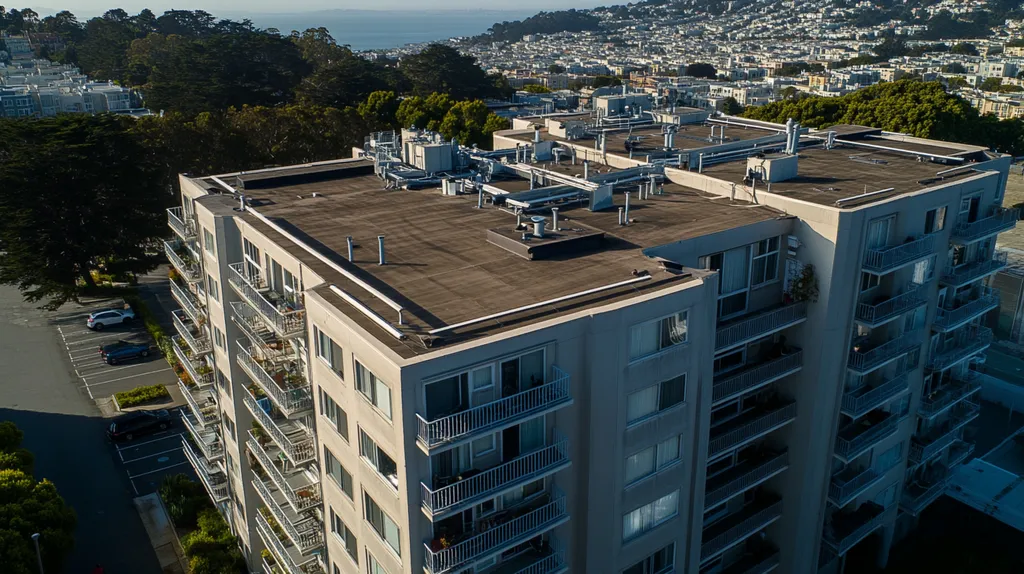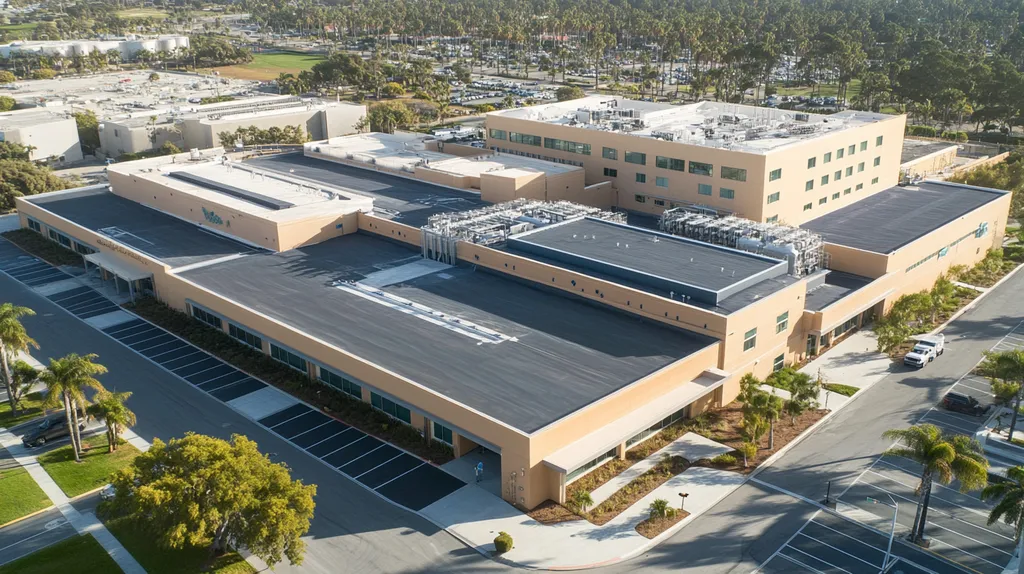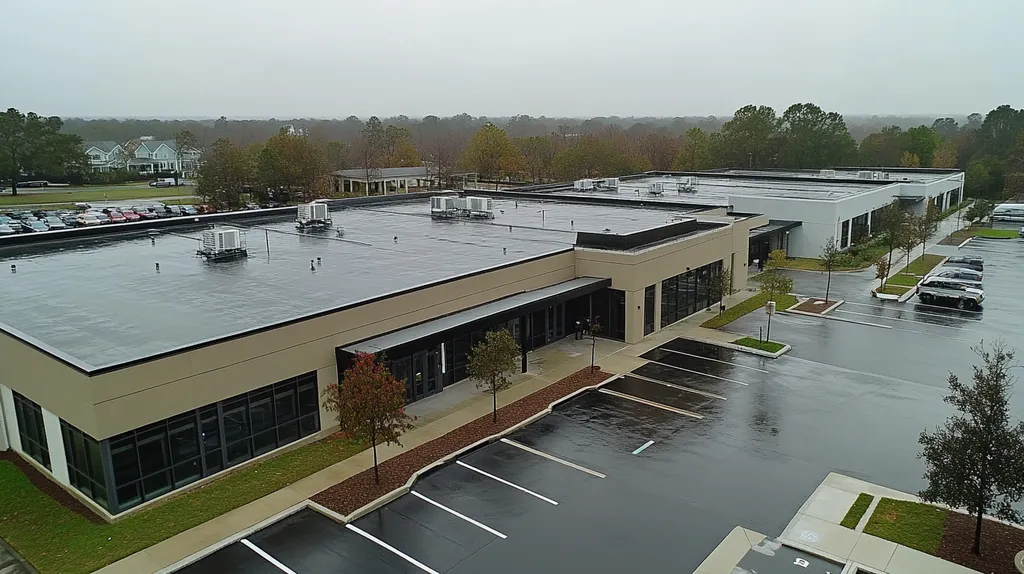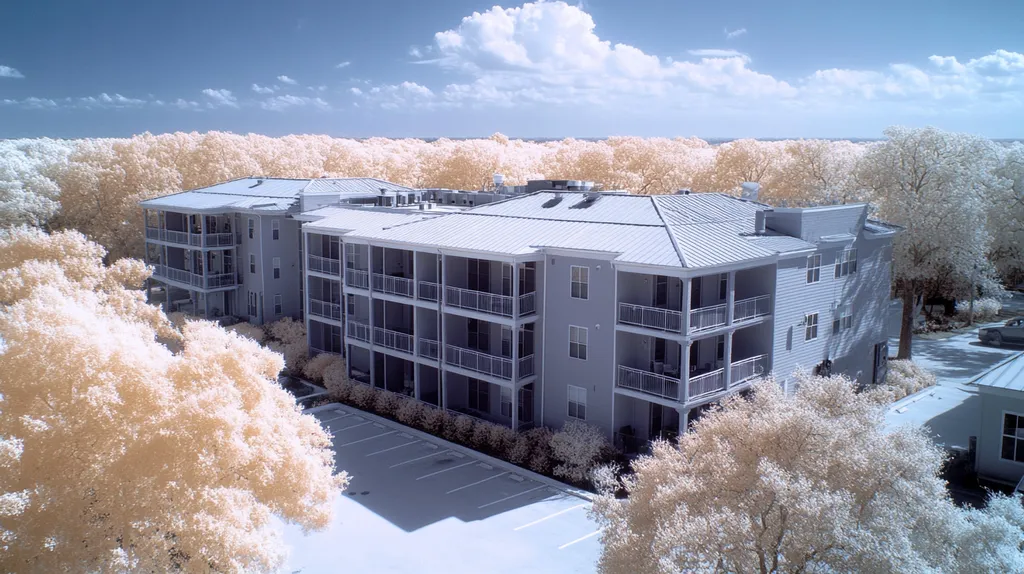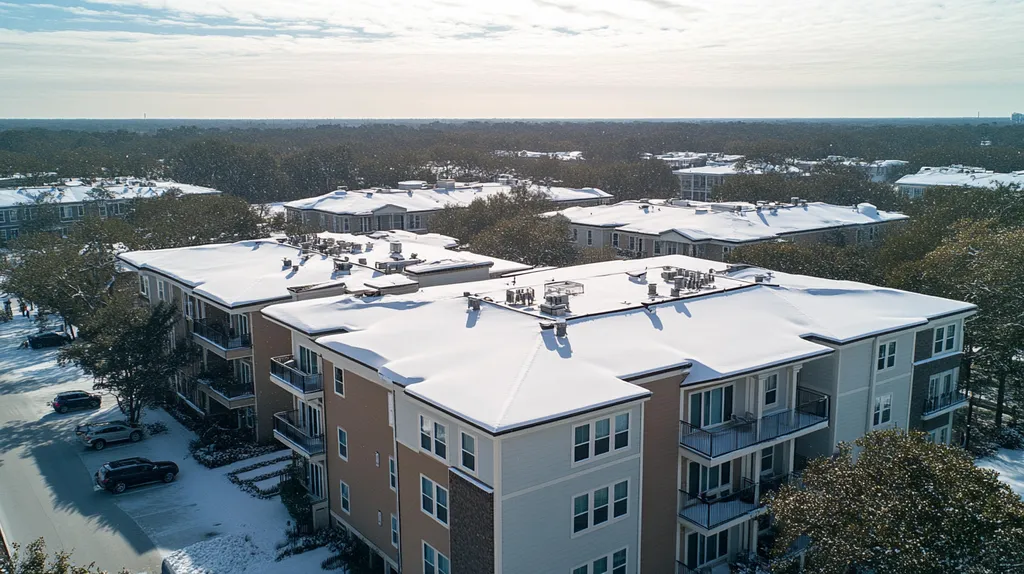Delaying compliance with industrial roofing standards costs U.S. businesses over $2.5 billion annually in preventable repairs and energy losses. Statistics show that non-compliant facilities face up to 40% higher maintenance expenses and significantly increased liability risks.
Understanding these implications is crucial for property owners and facility managers who must navigate complex regulatory requirements while protecting their investments.
This comprehensive guide examines the critical aspects of roofing compliance, from fundamental concepts and system components to implementation methods and performance metrics, providing actionable insights for maintaining safe, efficient, and code-compliant industrial roofs.
SECTION 1: FUNDAMENTAL CONCEPTS
Delayed compliance in industrial roofing can have dire and expensive consequences for property owners. Research indicates that facilities experiencing compliance delays may face maintenance costs that are up to 30% higher over time. Understanding the implications of these delays is crucial for maintaining operational efficiency and avoiding unnecessary liabilities. In this section, we will define delayed compliance, examine how it affects roof lifespan and deterioration, and explore the legal and insurance ramifications that come with ignoring necessary standards.
Definition of Delayed Compliance
Delayed compliance refers to the failure to adhere to established guidelines and regulations that govern roofing systems. These essential rules are typically outlined by local building codes, national standards, and manufacturer specifications. Ignoring these guidelines can postpone critical repairs and upgrades, putting the integrity of the roofing system at risk.
Property owners must understand that compliance extends beyond the installation of quality materials; it encompasses regular maintenance and timely inspections. For example, a roof that does not meet energy efficiency regulations can lead to higher energy consumption and resulting costs. The longer compliance is delayed, the greater the chance that serious problems will develop.
Additionally, delayed compliance can create confusion among property managers, contractors, and regulatory bodies. Miscommunication regarding responsibilities can intensify issues, creating a chain reaction of problems. A solid grasp of compliance obligations is crucial for proactive facility management.
Establishing a clear definition of delayed compliance lays the groundwork for understanding its impacts on both the roof’s condition and the facility’s legal responsibilities.
Roof Lifespan and Deterioration
The lifespan of an industrial roof hinges significantly on adherence to maintenance and repair regulations. Regular upkeep in accordance with these guidelines can extend the life of a roof by several years. In contrast, neglecting these standards contributes to premature deterioration and costly repairs.
For instance, a roof that lacks regular inspections may develop leaks that go unnoticed for months. These leaks can seriously damage the underlying structure, resulting in expensive repairs. Experts estimate that around 70% of roofing failures are linked to inadequate maintenance and compliance issues.
Moreover, roofing materials come with specific lifespans that are directly connected to their maintenance. Not complying with manufacturer recommendations can void warranties, potentially leaving property owners to cover the full costs of repairs and replacements.
Long periods of non-compliance not only harm the roof’s integrity but can also disrupt business operations. Thus, understanding the link between compliance and roof lifespan is vital for effective facility management.
Legal and Insurance Implications
The legal and insurance consequences of delayed compliance can be extensive and complicated. Failing to comply with building codes can expose property owners to lawsuits and hefty fines. If a roofing system fails because guidelines were not followed, legal liability could fall directly on the owner.
Additionally, insurance claims may be denied if it is determined that non-compliance played a role in the damages. For example, if a factory suffers a roof collapse and it is found that necessary maintenance standards were ignored, the insurer could refuse to cover the repair costs. This not only results in substantial financial burdens but can also tarnish a business’s reputation.
Furthermore, repeated non-compliance issues can lead to increased insurance premiums or challenges in securing coverage. Insurance companies closely evaluate compliance histories when determining rates or issuing policies.
In conclusion, the legal and financial ramifications of delayed compliance are significant. Property owners must prioritize adherence to regulations to protect their investments, reduce potential liabilities, and ensure smooth operations.
SECTION 2: SYSTEM COMPONENTS
The choice of roofing system components is pivotal in industrial environments, where the stakes are high. Delaying compliance with established standards can lead to accelerated wear on roofing materials, skyrocketing energy expenses, and even structural failures. Research shows that poor roofing decisions can decrease a building’s lifespan by up to 30%. It’s crucial for property owners and facility managers to grasp the importance of key components—such as materials, structural integrity, and insulation—when making informed roofing decisions.
Roofing Materials and Durability
The durability of roofing materials has a direct impact on compliance timelines and ongoing maintenance costs. Selecting inferior materials can heighten the risk of damage from common environmental challenges, including UV exposure and temperature fluctuations. This often leads to unforeseen repair expenses, diverting funds away from other critical areas of operation.
Additionally, compliance often demands that roofing materials meet minimum durability criteria. A failure to meet these standards can trigger inspections and possible penalties. Therefore, property owners must ensure their chosen materials can withstand wear while contributing to overall safety and longevity.
Investing in high-quality materials, such as thermoplastic polyolefin (TPO) or polyvinyl chloride (PVC), helps mitigate risks of early deterioration. These options not only comply with industry standards but also provide benefits in energy efficiency and durability. Making these choices is essential for effective risk management.
Ultimately, opting for robust roofing materials from the outset can prevent myriad compliance-related issues down the road, protecting both the structure and the financial well-being of the facility.
Structural Integrity and Support
Ensuring structural integrity is critical for any roofing system, particularly in industrial settings. A compromised structure can lead to compliance challenges and create unsafe working conditions. Facilities with roofs lacking adequate support are significantly more vulnerable to collapse, jeopardizing the safety of employees and equipment.
Regular inspections of roof support systems can uncover hidden issues before they escalate. Overlooking this element can result in substantial compliance costs, including legal fees and penalties for unsafe structures. Additionally, the financial outlay for reactive measures tends to surpass that of proactive maintenance.
Embracing advanced engineering techniques to reinforce structural integrity can avert failures with dire consequences. For instance, applying improved load distribution strategies can significantly ease stress on the roofing system.
Property owners must recognize that strong structural support is a cornerstone of their compliance strategy, enhancing safety and preserving property values.
Insulation and Energy Efficiency
Insufficient insulation can create compliance hurdles while amplifying energy expenses. Poorly insulated roofs allow heat to escape during winter and invade during summer, leading to inefficient energy consumption that may violate energy regulations—resulting in penalties.
Facility managers should emphasize high-performance insulation systems that align with energy codes. For example, rigid foam boards or spray foam materials can significantly improve thermal resistance, helping meet compliance standards while reducing energy costs.
Moreover, energy-efficient roofs support sustainability initiatives and minimize a facility’s overall environmental impact. Utilizing reflective roofing materials can decrease heat absorption, further meeting environmental regulations.
By prioritizing quality insulation, property owners achieve the dual benefits of regulatory compliance and cost savings, reinforcing the importance of strategic decision-making in roofing investments.
SECTION 3: IMPLEMENTATION METHODS
Delaying compliance with roofing codes can result in significant financial burdens and operational disruptions for industrial property owners. The National Roofing Contractors Association indicates that non-compliance heightens the risk of system failures, leading to expensive repairs and potential legal troubles. By proactively planning and adhering to regulations, property owners can safeguard both their roofing systems and business operations. This section will delve into effective scheduling, weather considerations, and navigating permitting requirements to ensure seamless compliance.
Scheduling and Project Planning
Effective scheduling is crucial for minimizing roofing issues linked to compliance delays. Property owners should craft a project timeline that incorporates all essential inspections and assessments. Skipping these steps can lead to scheduling conflicts, extending project durations unnecessarily and complicating compliance.
Engaging skilled roofing contractors early in the planning stages can streamline the compliance process. They can pinpoint time-sensitive tasks and prioritize them effectively within the overall timeline. Involving all stakeholders from the beginning reduces the risk of miscommunication, ensuring alignment throughout the project.
Moreover, thorough project planning should account for contingencies. Weather-related delays can thwart even the best schedules, but incorporating buffer times allows for flexibility. This adaptability is essential for managing unforeseen issues while adhering to compliance deadlines.
With a well-organized schedule in place, property owners can maintain better control over their compliance timelines, thereby minimizing the risk of not meeting regulatory requirements.
Weather and Environmental Considerations
Weather conditions have a significant influence on roofing compliance timelines. Rain, snow, or extreme heat can hinder both installation and inspections, causing unnecessary delays. Understanding local weather patterns equips property owners to plan more effectively during optimal work windows.
Additionally, environmental factors such as nearby construction can increase debris and introduce non-compliance hazards. Facility managers must stay alert to these factors, modifying their plans as needed to protect roofing integrity.
Utilizing weather-resistant materials is another proactive strategy to mitigate adverse conditions. Implementing high-quality roofing products not only supports compliance but also enhances the roof’s lifespan by better withstanding environmental stresses.
By strategically addressing weather and environmental considerations, property owners can ensure smoother operations, protecting both the structural integrity of their roofs and their overall investment.
Permitting and Regulatory Compliance
Navigating the permitting landscape is vital for maintaining roofing compliance. Many jurisdictions enforce specific codes regarding materials, installation methods, and safety standards. Overlooking these requirements can result in fines, project delays, and additional compliance challenges.
To ensure smooth compliance, property owners should engage with local building authorities well before starting any project. Securing necessary permits ahead of time clarifies expectations and minimizes the risk of compliance pitfalls later.
Accurate documentation is also crucial in the permitting process. Keeping detailed records of inspections, materials used, and contractor qualifications proves compliance. This documentation is invaluable if disputes arise in the future.
Ultimately, mastering the permitting process and adhering to regulations is essential. A compliant roofing project avoids potential legal challenges and enhances the long-term value of the property.
SECTION 4: MAINTENANCE REQUIREMENTS
Ignoring maintenance requirements for industrial roofs can lead to hefty repair bills and jeopardize safety. Routine inspections are a key preventative measure, designed to spot issues before they escalate into significant problems. Research shows that roofs receiving regular maintenance can last up to 30% longer than those that do not. This section underscores the importance of systematic inspections, distinguishes between minor and major repairs, and outlines effective preventive maintenance strategies.
Regular Inspection Protocols
Regular inspections are indispensable for preserving the integrity of industrial roofs. Property owners should aim to schedule these assessments at least biannually, ideally in spring and fall. Each inspection should thoroughly examine the roof’s surface, drainage systems, and flashing to identify damage early.
Utilizing specialized equipment to access hard-to-reach areas is critical during inspections. Catching issues like membrane tears or debris blockages early can prevent leaks and extensive structural damage. Maintaining a detailed maintenance log of inspection findings is crucial for tracking the roof’s condition over time.
Furthermore, many warranty agreements stipulate regular inspections. Neglecting to adhere to these requirements can void warranties, resulting in expensive repairs down the line. Proactively conducting inspections not only protects investments but aligns with warranty conditions, ensuring compliance.
Finally, enlisting qualified roofing professionals for these inspections guarantees expert evaluations, providing a comprehensive view of any potential roofing problems.
Addressing Minor vs. Major Repairs
Successful roof maintenance hinges on understanding the difference between minor and major repairs. Minor issues, such as small leaks or worn flashings, are typically easy and inexpensive to resolve. However, overlooking these small problems can lead to major repairs that come with higher costs.
Major repairs may involve large-scale issues, like structural reinforcements or significant membrane replacements, which can impose substantial financial burdens. Promptly addressing minor leaks, for instance, can avert severe water damage that threatens the entire roofing system.
Property owners should implement a systematic approach to document and categorize repairs. An organized repair schedule will help ensure timely attention to minor issues, preventing them from escalating into costly projects.
Establishing a clear escalation plan when minor repairs become ineffective is also essential. This proactive management strategy creates a framework for consistent, strategic decisions rather than reactive fixes.
Preventive Maintenance Strategies
Preventive maintenance is essential for prolonging the lifespan of industrial roofs. Regular cleaning to remove debris is crucial, as accumulation can cause water pooling and lead to leaks. A routine that focuses on clearing gutters and downspouts can significantly reduce water-related problems.
Investing in protective coatings can enhance roof durability considerably. These coatings reflect UV rays and reduce heat absorption, ultimately extending the life of roofing materials. Additionally, they provide an extra layer of insulation, improving overall energy efficiency of the building.
Creating an annual maintenance budget can help property owners anticipate costs associated with ongoing care and repairs. Allocating resources for preventive strategies keeps the roof in optimal condition.
Also, training in-house maintenance staff in basic roof care fosters a culture of awareness and responsibility. Well-informed teams can identify issues early, addressing them before they develop into larger problems.
SECTION 5: PERFORMANCE METRICS
Delaying compliance can drastically undermine the performance metrics of industrial roofs. This can lead to higher energy costs, increased water damage, and potential structural failures. For instance, a roof that falls short of energy efficiency standards could inflate heating and cooling expenses by as much as 30%. This section will explore the vital performance metrics that demand attention to compliance, helping to mitigate long-term risks and enhance operational efficacy.
Monitoring Energy Efficiency
Energy efficiency plays a crucial role in running a sustainable industrial operation. Ignoring energy standards can inflate utility bills, directly affecting profit margins. By adopting energy-efficient roofing options, businesses can potentially cut energy usage by up to 25%.
Regular assessments are essential for detecting insulation issues and thermal inefficiencies within roofing systems. Tools like infrared scans and energy modeling software allow facility managers to identify problem areas promptly. By addressing these concerns, companies can lower energy expenses while prolonging the lifespan of roofing materials.
Moreover, staying compliant with energy regulations can unlock beneficial financing options and tax credits. Many utility providers offer incentives for achieving energy efficiency benchmarks, enhancing the financial advantages of compliance. Incorporating these metrics into long-term maintenance strategies is crucial for sustainable operations.
In conclusion, consistent monitoring of energy performance not only boosts efficiency but also cultivates a corporate image that values sustainability and innovation.
Tracking Water Infiltration and Leaks
Water infiltration poses a significant threat to the integrity of industrial roofs. Delayed action in addressing potential leaks can result in severe water damage and costly repairs. Data shows that water damage represents about 20% of all commercial property insurance claims.
Conducting regular inspections combined with advanced leak detection technologies can greatly reduce these risks. Using moisture meters and thermal imaging tools allows for early identification of infiltration points, preventing minor issues from developing into major problems. Prompt response is critical for maintaining the roofing structure and safeguarding underlying materials.
Facility managers should adopt a systematic approach to track leaks and water damage events. This data-driven method enhances budget forecasting and maintenance planning, leading to more effective compliance efforts.
Ultimately, diligent tracking of water infiltration not only protects assets but also strengthens overall operational resilience.
Assessing Structural Stability
Structural stability is a key performance metric that directly affects both safety and longevity. Delaying structural assessments can lead to severe failures, which could bear significant financial and liability consequences. Research indicates that neglecting structural integrity can raise repair costs by as much as 50% over time.
Routine evaluations of roofing structures are vital for detecting potential weaknesses and compliance gaps. Property owners can uphold necessary standards by performing load analyses and structural assessments, ensuring roofs can handle heavy equipment and environmental pressures, such as snow and wind.
Investing in reinforcing structural elements during the design phase can prevent future compliance pitfalls. Choices regarding materials, effective drainage systems, and adherence to building codes all contribute to a roof’s long-term stability.
In essence, ongoing assessments of structural stability are not just a recommended practice; they are essential for ensuring operational efficiency and safety in industrial roofing.
SECTION 5: PERFORMANCE METRICS
When compliance is delayed, the performance metrics of industrial roofs take a hit, leading to increased operational costs and structural risks. A non-compliant roof can raise energy expenses for heating and cooling by up to 30%. This section addresses critical metrics that demand consistent attention to compliance in order to mitigate long-term risks and boost operational performance.
Monitoring Energy Efficiency
Energy efficiency is crucial for sustainable industrial operations. Failing to meet energy standards can lead to inflated utility bills, placing pressure on profit margins. By choosing energy-efficient roofing options, businesses can typically reduce their energy consumption by as much as 25%.
Conducting regular assessments allows facility managers to uncover insulation failures or thermal inefficiencies. Tools like infrared scans and energy modeling software can help pinpoint trouble spots early on. Addressing these issues promptly cuts energy costs and extends the life of roofing materials.
Additionally, compliance with energy regulations opens doors to favorable financing options and tax credits. Utility companies often provide incentives for meeting energy efficiency benchmarks, amplifying the financial gains related to compliance. Incorporating these metrics into long-term maintenance strategies is essential for ongoing success.
Ultimately, consistent monitoring of energy performance not only boosts operational efficiency but also promotes a corporate image dedicated to sustainability and innovation.
Tracking Water Infiltration and Leaks
Water infiltration is among the most pressing threats to industrial roof integrity. Delayed action in addressing potential leaks can lead to extensive damage and costly repairs. In fact, water damage is responsible for around 20% of all commercial property insurance claims.
Regular inspections combined with advanced leak detection technologies can minimize these risks significantly. Utilizing tools such as moisture meters and thermal imaging enables early identification of infiltration points before they escalate into serious issues. Taking prompt action helps preserve the roofing structure and protects the underlying materials from damage.
Facility managers should establish a systematic approach to track leaks and water damage events. This data-driven strategy enhances maintenance planning and budgeting, improving compliance efforts overall.
In conclusion, diligent tracking of water infiltration and leaks not only protects assets but also strengthens overall operational resilience.
Assessing Structural Stability
Structural stability is a critical performance metric directly affecting both safety and roof longevity. Delaying structural assessments can result in severe failures, carrying significant financial and liability risks. Research indicates that neglecting structural integrity can increase repair costs by up to 50% over time.
Routine evaluations of roofing structures are essential for detecting potential weaknesses and compliance gaps. Using load analysis and structural assessments, property owners can ensure that roofs can support heavy equipment and withstand environmental stressors like snow and wind.
Investing in reinforcing structural elements during the design phase can mitigate future compliance issues. Choices concerning materials, effective drainage systems, and adherence to building codes fundamentally influence a roof’s long-term stability.
In essence, ongoing assessments of structural stability are not just a best practice; they are vital for ensuring operational efficiency and safety in industrial roofing.
The Bottom Line
The financial impact of delayed roofing compliance continues to grow, with U.S. businesses losing over $2.5 billion annually in preventable damages and inefficiencies.
Property owners who postpone necessary upgrades and maintenance face up to 40% higher repair costs, along with increased liability exposure and potential insurance claim denials.
Regular inspections, proper material selection, and adherence to building codes are not merely regulatory requirements—they represent critical investment protections.
By implementing robust maintenance protocols and monitoring key performance metrics, facility managers can extend roof lifespans by 25-30% while significantly reducing operational costs.
The path forward requires immediate action: addressing compliance gaps today prevents exponentially larger expenses tomorrow while ensuring the safety and efficiency of industrial facilities.
FREQUENTLY ASKED QUESTIONS
Q. What is delayed compliance on industrial roofs?
A. Delayed compliance refers to failing to follow established rules and regulations for roofing systems. This oversight can lead to increased maintenance costs, reduced roof lifespan, and potential legal issues. Understanding compliance is essential for maintaining the roof’s integrity and ensuring operational efficiency.
Q. How do roofing materials impact compliance and durability?
A. The choice of roofing materials significantly influences compliance and the roof’s durability. Poor-quality materials can accelerate wear and necessitate more frequent repairs, increasing long-term costs. Selecting high-grade materials ensures adherence to industry standards, enhances longevity, and minimizes future compliance-related issues.
Q. Why is scheduling important for industrial roof compliance?
A. Scheduling is crucial because it helps coordinate inspections and maintenance activities to meet compliance deadlines. A well-planned timeline reduces the risk of oversight and ensures that necessary tasks are completed on time. This proactive approach minimizes the chances of compliance issues arising due to delays.
Q. How does regular inspection support roof compliance?
A. Regular inspections are essential for identifying and resolving issues before they escalate. These assessments help ensure that the roof adheres to compliance standards, preserving its integrity and safety. By keeping a record of inspections, property owners can also meet warranty requirements and minimize potential liabilities.
Q. What performance metrics should be monitored for roofs?
A. Key performance metrics to monitor include energy efficiency, water infiltration, and structural stability. Paying attention to these areas helps maintain compliance and extends the lifespan of the roof. Regular assessments enable facility managers to proactively address issues, ensuring operational efficiency and safety.
Q. How can facility managers improve compliance with roofing standards?
A. Facility managers can enhance compliance by establishing clear maintenance schedules, utilizing quality materials, and conducting regular inspections. Staying informed about local regulations and industry standards also plays a vital role. This proactive approach will safeguard the roof’s integrity and mitigate potential financial liabilities.
Q. What are the legal implications of delayed compliance on roofs?
A. Delayed compliance can expose property owners to legal liabilities and financial penalties. Non-compliance may result in lawsuits, denied insurance claims, and increased premiums. Prioritizing adherence to regulations protects investments and ensures smoother operations, preventing costly legal challenges associated with non-compliance.

